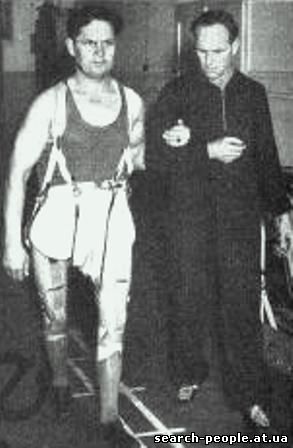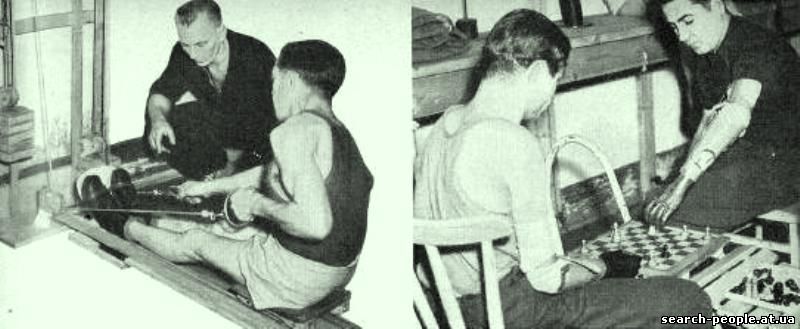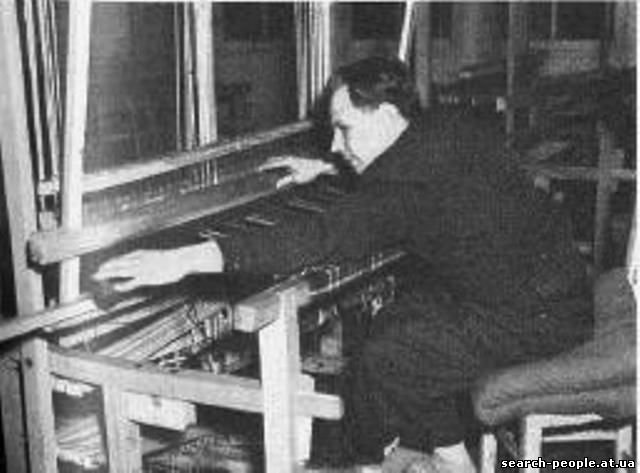Dear visitors
Could you help me please find information about my uncle Piotr Bozyk (During his work) in Area Vocational Training School. Ingolstadt, Bavaria, Germany 1948-1949.
I am looking for information about my uncle Piotr Bozyk. From information International Tracing Service of the International Red Cross he was a Policeman IRO in Area Vocational Training School. Ingolstadt, Bavaria, Germany
(Photo - Piotr Bozyk)
2.1948-4.1949 Piotr Bozyk - Policeman IRO. Area Vocational Training School. Ingolstadt, Bavaria, Germany
The information send me please on the address:
Bohdan Hnatyk
Sheptytzky St 1/179
Novoyavorivsk 81053
Lviv.Ukraine.
Rehabilitation for Emigration
By ARCHIE S. LANG Chief, Displaced Population Branch, OLC Bavaria
(Information Bulletin. IRO April 1951)
Two Vocational Training school – one of which doubles as rehabilitation center – have been helping the International Refugee Organization to speed emigration of displaced persons to the new homes they desire.
These institutions are the IRO-sponsored Vocational Training School at Ingolstadt and combined Vocational School-Rehabilitation Center at Neuburg-Donau, both in Bavaria. Both were established with one aim in mind: to help displaced persons develop marketable skills which will make easier their search for jobs in foreign countries.
At Ingolstadt, the unskilled are learning the fundamentals of such trades as dressmaking, tailoring, welding, typing, auto repair, bricklaying, draughting, carpentry and plumbing. Coupled with such instruction at Neuburg-Donau are physical therapy treatment for amputees, the blind and persons suffering from tuberculosis.
At the time these schools were conceived, the International Refugee Organization made exhaustive studies of the labor needs of countries accepting immigrants. Courses were then established based on this information. However, in the planning, scope and technique were strongly influenced by experiments with intensified training for war industry which the United States instituted during World War II. Every effort was made to eliminate extraneous instruction, so that within the shortest possible time a student would be qualified to do finished work in the professional world. The students were not to become highly-skilled workers but competent, general tradesmen.
The Vocational Training school at Ingolstadt was established March 15, 1948, in a badly-damaged military Kaserne (barracks) which for some time had served as a DP transient camp. Extensive repair was necessary to make the kaserne usable as a school but by no means were all of the buildings reconstructed. Today at least one-third of the area surrounding the school buildings is filled with the hulks of wartime destruction.
Like Ingolstadt, the Neuburg center was established in a former military Kaserne, which had served a hitch as a camp for transient DP's. Prior to its opening as a school, on Aug. 6, 1949, however, it had served as a hospital for the tubercular. The problems of repairing and refurbishing this installation, which had hardly been scathed by bombs, took second place to the problem of persuading prospective trainees that they would not contract tuberculosis by living and working there.
Admission to the schools is achieved through application at IRO offices. Persons naturally can be taken only on a space-available basis; they are further required to take certain aptitude tests to determine their eligibility. The courses – 17 of them – are divided into units of three months each at Ingolstadt, and a similar program is offered at Neuburg.
The Neuburg center was founded with the special aim of broadening the immigration possibilities for that group of displaced persons termed "hard core” – a group which includes persons badly handicapped by age, illness, blindness and amputation. Originally planned to serve arm and leg amputees, the center geared its program to muscle retraining, corrective fitting of artificial limbs, and vocational therapy. It has since expanded its service to include a program for blind persons, and to therapy (physical and vocational) for rheumatics and cardiacs. Most services are still directed toward needs of amputees.
The vocational aspect of the center includes some 21 courses, five of which are exclusively for the blind. The combination of vocational and rehabilitative schooling at the center was effected for definite purposes. Not only was it more practical to house the two under one roof, but it was felt that if disabled persons trained in conjunction with the non-disabled, they would have a far better opportunity realistically to assess their productive records.
The International Refugee Organization proposes to continue the center at Neuburg for an indeterminate period, largely dependent on the funds available.
The vocational training school at Ingolstadt, on the other hand, has been offered as a gift to the Bavarian government, provided the school will continue to operate under substantially the same program. This proposed gift involves the transfer of approximately $200,000 worth of machinery and equipment, and sufficient supplies to guarantee operation for a three-months course for the 500-capacity student body.
At present Ingolstadt offers a 13-week program of instruction, 40 hours a week, minimizing theory and stressing practice. In setting up the instruction schedule it was recognized that much of the theory traditionally included in vocational training has little if any value in the initial stages; in any case, it was an almost insurmountable obstacle to attempt teaching theory to persons who spoke a mélange of five or six languages.
The aptitude tests which each entering student was obliged to undergo were designed to cut down the margin of error- and wasted effort – that might result from enrollment in an unsuitable course. The examinations held during and upon completion of the course yield ratings from "very good” to "poor” it is possible for a student who is failing to change his course and perhaps benefit thereby.

Double amputees new limbs with, without walking aids at Rehabilitation Center and Vocational Training School for disabled and blind Displaced Persons established by the International Refugee Organization (IRO) in Bavaria. There are approximately 200 disabled among 400 DP's at center.

Amputees undergo training while awaiting artificial limbs.
Blind inmates learn to make household brushes by hand.

a) b)
a)Disabled DP is put through course of exercises designed to restore use of limbs. Instructor supervises workouts.
b)Pair of disabled inmates relax over game of chess after classroom studies at IRO's Vocational Training School.
Since the school's opening, approximately 3,000 students have received training. These include Poles, Russians, Ukrainians, Czechs, Yugoslavs, Hungarians and persons of other nationalities, Courses are taught in German but most instructors are multilingual. Of the 128 employees at Ingolstadt, 62 are members of the teaching staff.
Included in the roster of courses offered at the center are those for auto electricians, auto mechanics, bricklayers, draftsmen, electro-installers, carpenters, machinists, locksmiths, tinsmiths, plumbers, painter-glaziers, radio-servicers, seamstresses, shoe repairmen, tailors, welders and typists.
Supplementing these basic courses, advanced training is given to the most accomplished students. Advanced courses include those for plasterers, machine designers, electromechanics, cabinetmakers, machinists, radio mechanics, dressmakers, shoemakers, tailors and welders.
The International Refugee Organization has foreseen that some thousands of its former charges must remain in Germany after its phase-out and has estimated the one of their most pressing needs will be employment within the German economy. Many of these residual DP's have no skill or they require retraining. Despite its closure, planned for September 1951, IRO still feels responsibility for these persons and is endeavoring to make long-term provision for them.
It is for these reasons that IRO has offered the school to the Bavarian State Government. The gift, however, will not be limited in its future service to displaced persons, but is to be made available to Germans – perhaps as many as 250 out of the 500 persons the school accommodates. (Interestingly enough, the center constantly receives calls from Germans – natives and refugees- asking for admission.)
In February an agreement was reached assigning responsibility for the school to the Bavarian Ministry of the Interior. Work preliminary to the transfer was scheduled to take place last month and the first classes under German supervision will begin in April, perpetuating the work toward recovery instituted by the IRO at Ingolstadt three years ago.

Blind DP operating weaving machine is one of many learning a new to facilitate either their emigration or integration into the German economy.
Below, extreme right, Mrs. Raymonde Bruguiere, supervisor of the IRO center, and,1-r., Birger Berg, HICOG resident officer at Ingolstadt; Archie S. Lang, chief, Displaced Populations Branch, OLCB, and Josef Wartha, manager of vocational school, and Neuburg reporter.
Джерело: http://www.search-people.at.ua | 